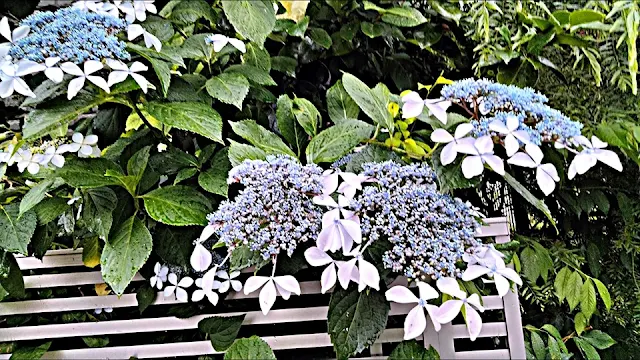今日も一日雨でしたが、朝の散歩の時間帯は一時的に止んでいたのでラッキーでした。「柿の木広場」に入ると、スバル君がいました。ワンコも雨はうっとおしいのか、沈んだ面持ちで動きません。
Another rainy day. Luckily, we managed to catch the brief time when the rain stopped. When we arrived at the Persimmon Park, our friend Subaru was already there with his mom. It seems dogs also hate the rain, and Subaru seemed despondent.
タイガは家を出たときからやる気のない散歩で、スバル君との挨拶もそこそこに、あくびをしながら前を通り過ぎました。
Taiga was not eager for a walk since we left home, and after a brief greeting with Subaru, she walked away with a big yawn.
ごめんね、スバル君。
Sorry, Subaru, for Taiga's manners.
柿の木広場のすぐ近くに住むサスケが、草地の奥のほうから近づいてきました。タイガといつもの挨拶。
Sasuke, who lives near the Persimmon Park, was at the deep end of the field and came towards Taiga. He started his usual greeting with her.
こうやってタイガに強気で近づきます。サスケの耳、尻尾、後ろ脚の状態から、自分を強く見せたいのが伺えます。飼い主さん曰く、タイガが唯一の友達だそうですが、
He always approaches her in a domineering manner, with his ears, tail and the way he holds his hind legs, all suggesting that he wants to look strong. According to his dad, Taiga is the only friend he has, and other dogs do not allow him to come near.
強気で挨拶をしてくるので、タイガが突き放しました。サスケは拍子抜けした顔ですが、いつもこれです。これと対照的なのが、サスケの家の前で塀越しに挨拶するとき。サスケが外に出ているときに通り過ぎると、タイガを見つけて鼻をならし哀れな目つきで柵の間から顔を突き出します。タイガは興味なさそうに塀の外の芝生の上でオシッコをして、挨拶は私にまかせます。
Taiga pushed him away for his abrasive manner, leaving him looking lost, but it always goes like this. In contrast, the way he greets Taiga at his house is very different. If we walk in front of his house when he happens to be in the garden, he pushes his snout through the fence and looks at Taiga with a whine and piteous eyes. Taiga takes no notice of him and starts peeing on the lawn outside of the fence, leaving me to stroke him through the fence.
その後、道路の向かいの茂呂山公園へ行きました。この公園には住所がついているようです。
Later, we crossed the road and went to the Moroyama Park. This park has its own address.
ここは板橋区。練馬区は基本的に公園に犬は入場禁止だそうです。板橋区はどうなのか分かりませんが、茂呂山公園も柿の木広場も都立城北公園の一部なので、ワンコOKです。
This park is situated in Itabashi Ward. We live in Nerima Ward, where dogs are not allowed into parks. I do not know the rules in Itabashi Ward, but fortunately, both Moroyama and Persimmon Parks belong to the Johoku Park which comes under the management of the Tokyo Metropolitan Government which allows dogs into parks.
いかにも湿度の高い風景。
The air was heavy with moisture.
公園の上の広場に着くと、
When we arrived at the top of the hill,だれもいない。
there was no-one else.
広場に植わっているのはモミジと桜の木。
Here, the trees are Japanese maples and cherry trees.
歩く気のないタイガと、のらりくらりその辺を回ってみました。
We ambled, with Taiga ready to go home any second.
モミジの枝が雨で重たそうです。
The maple branches were heavy with rainwater.
公園近くの民家のヤマアジサイ。つい先日まではもっと濃い青だったのが、咲き進んだからか色が薄くなってきました。
The Japanese rainy season and hydrangeas are inseparable. These are wild hydrangeas that you see in mountain creeks and valleys. Some people like them for their simple appearance.
こちらは園芸種。同じ一株の花なのに、このように紫がかったものや、濃い青など変化があります。
This is a cultivated variety. The flowers of this tree seem to vary in colour, with some bunches in deep blue, and others like this one looking purplish.
帰宅途中でまた雨が降り出しました。私が雨の中 庭の植物を見回っているあいだ、タイガが相変わらず天気にうんざりした様子でした。
It started to rain again on our way home. While I was looking at the plants in the garden, Taiga was flat on her stomach looking fed up with the rain.

































































